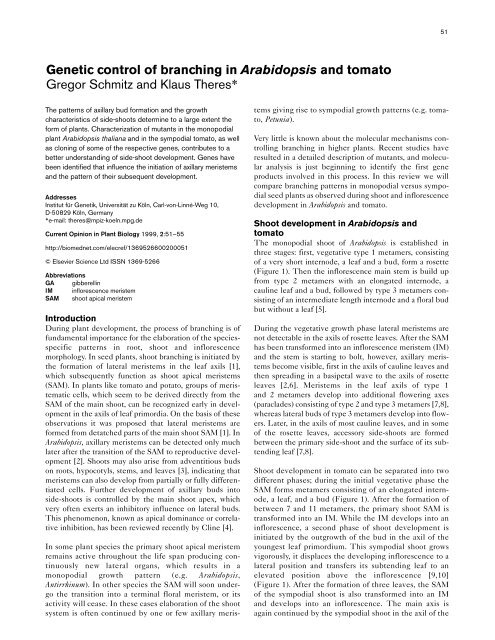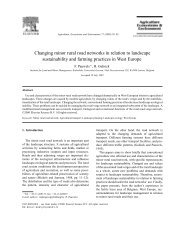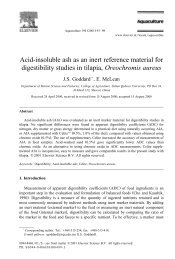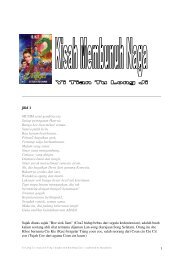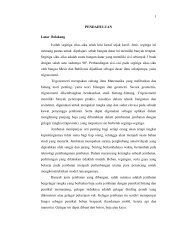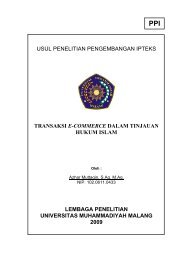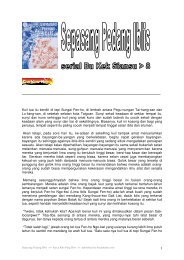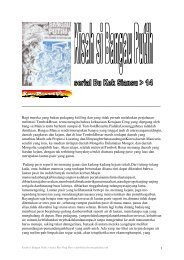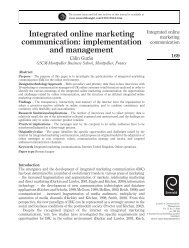Genetic control of branching in Arabidopsis and ... - Directory UMM
Genetic control of branching in Arabidopsis and ... - Directory UMM
Genetic control of branching in Arabidopsis and ... - Directory UMM
Create successful ePaper yourself
Turn your PDF publications into a flip-book with our unique Google optimized e-Paper software.
<strong>Genetic</strong> <strong>control</strong> <strong>of</strong> <strong>branch<strong>in</strong>g</strong> <strong>in</strong> <strong>Arabidopsis</strong> <strong>and</strong> tomato<br />
Gregor Schmitz <strong>and</strong> Klaus Theres*<br />
The patterns <strong>of</strong> axillary bud formation <strong>and</strong> the growth<br />
characteristics <strong>of</strong> side-shoots determ<strong>in</strong>e to a large extent the<br />
form <strong>of</strong> plants. Characterization <strong>of</strong> mutants <strong>in</strong> the monopodial<br />
plant <strong>Arabidopsis</strong> thaliana <strong>and</strong> <strong>in</strong> the sympodial tomato, as well<br />
as clon<strong>in</strong>g <strong>of</strong> some <strong>of</strong> the respective genes, contributes to a<br />
better underst<strong>and</strong><strong>in</strong>g <strong>of</strong> side-shoot development. Genes have<br />
been identified that <strong>in</strong>fluence the <strong>in</strong>itiation <strong>of</strong> axillary meristems<br />
<strong>and</strong> the pattern <strong>of</strong> their subsequent development.<br />
Addresses<br />
Institut für Genetik, Universität zu Köln, Carl-von-L<strong>in</strong>né-Weg 10,<br />
D-50829 Köln, Germany<br />
*e-mail: theres@mpiz-koeln.mpg.de<br />
Current Op<strong>in</strong>ion <strong>in</strong> Plant Biology 1999, 2:51–55<br />
http://biomednet.com/elecref/1369526600200051<br />
© Elsevier Science Ltd ISSN 1369-5266<br />
Abbreviations<br />
GA gibberell<strong>in</strong><br />
IM <strong>in</strong>florescence meristem<br />
SAM shoot apical meristem<br />
Introduction<br />
Dur<strong>in</strong>g plant development, the process <strong>of</strong> <strong>branch<strong>in</strong>g</strong> is <strong>of</strong><br />
fundamental importance for the elaboration <strong>of</strong> the speciesspecific<br />
patterns <strong>in</strong> root, shoot <strong>and</strong> <strong>in</strong>florescence<br />
morphology. In seed plants, shoot <strong>branch<strong>in</strong>g</strong> is <strong>in</strong>itiated by<br />
the formation <strong>of</strong> lateral meristems <strong>in</strong> the leaf axils [1],<br />
which subsequently function as shoot apical meristems<br />
(SAM). In plants like tomato <strong>and</strong> potato, groups <strong>of</strong> meristematic<br />
cells, which seem to be derived directly from the<br />
SAM <strong>of</strong> the ma<strong>in</strong> shoot, can be recognized early <strong>in</strong> development<br />
<strong>in</strong> the axils <strong>of</strong> leaf primordia. On the basis <strong>of</strong> these<br />
observations it was proposed that lateral meristems are<br />
formed from detatched parts <strong>of</strong> the ma<strong>in</strong> shoot SAM [1]. In<br />
<strong>Arabidopsis</strong>, axillary meristems can be detected only much<br />
later after the transition <strong>of</strong> the SAM to reproductive development<br />
[2]. Shoots may also arise from adventitious buds<br />
on roots, hypocotyls, stems, <strong>and</strong> leaves [3], <strong>in</strong>dicat<strong>in</strong>g that<br />
meristems can also develop from partially or fully differentiated<br />
cells. Further development <strong>of</strong> axillary buds <strong>in</strong>to<br />
side-shoots is <strong>control</strong>led by the ma<strong>in</strong> shoot apex, which<br />
very <strong>of</strong>ten exerts an <strong>in</strong>hibitory <strong>in</strong>fluence on lateral buds.<br />
This phenomenon, known as apical dom<strong>in</strong>ance or correlative<br />
<strong>in</strong>hibition, has been reviewed recently by Cl<strong>in</strong>e [4].<br />
In some plant species the primary shoot apical meristem<br />
rema<strong>in</strong>s active throughout the life span produc<strong>in</strong>g cont<strong>in</strong>uously<br />
new lateral organs, which results <strong>in</strong> a<br />
monopodial growth pattern (e.g. <strong>Arabidopsis</strong>,<br />
Antirrh<strong>in</strong>um). In other species the SAM will soon undergo<br />
the transition <strong>in</strong>to a term<strong>in</strong>al floral meristem, or its<br />
activity will cease. In these cases elaboration <strong>of</strong> the shoot<br />
system is <strong>of</strong>ten cont<strong>in</strong>ued by one or few axillary meris-<br />
51<br />
tems giv<strong>in</strong>g rise to sympodial growth patterns (e.g. tomato,<br />
Petunia).<br />
Very little is known about the molecular mechanisms <strong>control</strong>l<strong>in</strong>g<br />
<strong>branch<strong>in</strong>g</strong> <strong>in</strong> higher plants. Recent studies have<br />
resulted <strong>in</strong> a detailed description <strong>of</strong> mutants, <strong>and</strong> molecular<br />
analysis is just beg<strong>in</strong>n<strong>in</strong>g to identify the first gene<br />
products <strong>in</strong>volved <strong>in</strong> this process. In this review we will<br />
compare <strong>branch<strong>in</strong>g</strong> patterns <strong>in</strong> monopodial versus sympodial<br />
seed plants as observed dur<strong>in</strong>g shoot <strong>and</strong> <strong>in</strong>florescence<br />
development <strong>in</strong> <strong>Arabidopsis</strong> <strong>and</strong> tomato.<br />
Shoot development <strong>in</strong> <strong>Arabidopsis</strong> <strong>and</strong><br />
tomato<br />
The monopodial shoot <strong>of</strong> <strong>Arabidopsis</strong> is established <strong>in</strong><br />
three stages: first, vegetative type 1 metamers, consist<strong>in</strong>g<br />
<strong>of</strong> a very short <strong>in</strong>ternode, a leaf <strong>and</strong> a bud, form a rosette<br />
(Figure 1). Then the <strong>in</strong>florescence ma<strong>in</strong> stem is build up<br />
from type 2 metamers with an elongated <strong>in</strong>ternode, a<br />
caul<strong>in</strong>e leaf <strong>and</strong> a bud, followed by type 3 metamers consist<strong>in</strong>g<br />
<strong>of</strong> an <strong>in</strong>termediate length <strong>in</strong>ternode <strong>and</strong> a floral bud<br />
but without a leaf [5].<br />
Dur<strong>in</strong>g the vegetative growth phase lateral meristems are<br />
not detectable <strong>in</strong> the axils <strong>of</strong> rosette leaves. After the SAM<br />
has been transformed <strong>in</strong>to an <strong>in</strong>florescence meristem (IM)<br />
<strong>and</strong> the stem is start<strong>in</strong>g to bolt, however, axillary meristems<br />
become visible, first <strong>in</strong> the axils <strong>of</strong> caul<strong>in</strong>e leaves <strong>and</strong><br />
then spread<strong>in</strong>g <strong>in</strong> a basipetal wave to the axils <strong>of</strong> rosette<br />
leaves [2,6]. Meristems <strong>in</strong> the leaf axils <strong>of</strong> type 1<br />
<strong>and</strong> 2 metamers develop <strong>in</strong>to additional flower<strong>in</strong>g axes<br />
(paraclades) consist<strong>in</strong>g <strong>of</strong> type 2 <strong>and</strong> type 3 metamers [7,8],<br />
whereas lateral buds <strong>of</strong> type 3 metamers develop <strong>in</strong>to flowers.<br />
Later, <strong>in</strong> the axils <strong>of</strong> most caul<strong>in</strong>e leaves, <strong>and</strong> <strong>in</strong> some<br />
<strong>of</strong> the rosette leaves, accessory side-shoots are formed<br />
between the primary side-shoot <strong>and</strong> the surface <strong>of</strong> its subtend<strong>in</strong>g<br />
leaf [7,8].<br />
Shoot development <strong>in</strong> tomato can be separated <strong>in</strong>to two<br />
different phases; dur<strong>in</strong>g the <strong>in</strong>itial vegetative phase the<br />
SAM forms metamers consist<strong>in</strong>g <strong>of</strong> an elongated <strong>in</strong>ternode,<br />
a leaf, <strong>and</strong> a bud (Figure 1). After the formation <strong>of</strong><br />
between 7 <strong>and</strong> 11 metamers, the primary shoot SAM is<br />
transformed <strong>in</strong>to an IM. While the IM develops <strong>in</strong>to an<br />
<strong>in</strong>florescence, a second phase <strong>of</strong> shoot development is<br />
<strong>in</strong>itiated by the outgrowth <strong>of</strong> the bud <strong>in</strong> the axil <strong>of</strong> the<br />
youngest leaf primordium. This sympodial shoot grows<br />
vigorously, it displaces the develop<strong>in</strong>g <strong>in</strong>florescence to a<br />
lateral position <strong>and</strong> transfers its subtend<strong>in</strong>g leaf to an<br />
elevated position above the <strong>in</strong>florescence [9,10]<br />
(Figure 1). After the formation <strong>of</strong> three leaves, the SAM<br />
<strong>of</strong> the sympodial shoot is also transformed <strong>in</strong>to an IM<br />
<strong>and</strong> develops <strong>in</strong>to an <strong>in</strong>florescence. The ma<strong>in</strong> axis is<br />
aga<strong>in</strong> cont<strong>in</strong>ued by the sympodial shoot <strong>in</strong> the axil <strong>of</strong> the
52 Growth <strong>and</strong> development<br />
Figure 1<br />
<strong>Arabidopsis</strong><br />
Vegetative side-shoot<br />
Infloral side-shoot (paraclade)<br />
Accessory side-shoot<br />
Type3<br />
metamers<br />
Type2<br />
metamers<br />
Type1<br />
metamers<br />
Schematic representation compar<strong>in</strong>g shoot development <strong>in</strong><br />
<strong>Arabidopsis</strong> <strong>and</strong> tomato. The primary shoot is illustrated <strong>in</strong> black,<br />
lateral axes <strong>of</strong> successive order <strong>in</strong> grey. In <strong>Arabidopsis</strong>, the primary<br />
meristem forms the ma<strong>in</strong> plant axis, consist<strong>in</strong>g <strong>of</strong> a rosette, a bolt<strong>in</strong>g<br />
stem <strong>and</strong> an <strong>in</strong>determ<strong>in</strong>ate <strong>in</strong>florescence. Side-shoots orig<strong>in</strong>at<strong>in</strong>g from<br />
type1 <strong>and</strong> type2 metamers (paraclades) are <strong>in</strong>floral <strong>and</strong> repeat the<br />
development <strong>of</strong> the bolt<strong>in</strong>g stem. Accessory side-shoots are <strong>of</strong>ten<br />
formed between the primary side-shoot <strong>and</strong> its subtend<strong>in</strong>g leaf. In<br />
tomato, the primary shoot meristem forms the first segment <strong>of</strong> the<br />
sympodial stem term<strong>in</strong>at<strong>in</strong>g <strong>in</strong> the first <strong>in</strong>florescence. In all leaf axils,<br />
vegetative side-shoots are formed. The side-shoot <strong>in</strong> the axil <strong>of</strong> the<br />
youngest leaf primordium. In wild-type tomato plants<br />
this iterative phase <strong>of</strong> shoot development can progress<br />
<strong>in</strong>def<strong>in</strong>itely [10].<br />
Microscopic studies reveal, that, <strong>in</strong> contrast to<br />
<strong>Arabidopsis</strong>, axillary buds <strong>in</strong> tomato are formed early <strong>in</strong><br />
development <strong>in</strong> all axils <strong>of</strong> leaf primordia [11]. Due to the<br />
weak correlative <strong>in</strong>hibition by the shoot apex these buds<br />
develop <strong>in</strong>to side-shoots without a rest<strong>in</strong>g phase [12],<br />
repeat<strong>in</strong>g at least part <strong>of</strong> the development <strong>of</strong> the primary<br />
shoot [13]. As all nodes <strong>of</strong> a side-shoot can aga<strong>in</strong> form lateral<br />
shoots, this pattern can be repeated <strong>in</strong>def<strong>in</strong>itely,<br />
result<strong>in</strong>g <strong>in</strong> a very bushy growth habit.<br />
Tomato<br />
Infloral meristem<br />
Flower<br />
Leaf<br />
Second<br />
sympodial unit<br />
First<br />
sympodial unit<br />
Primary<br />
shoot<br />
Current Op<strong>in</strong>ion <strong>in</strong> Plant Biology<br />
youngest leaf primordium grows vigorously, pushes the <strong>in</strong>florescence<br />
to a lateral position, <strong>and</strong> transfers its subtend<strong>in</strong>g leaf to an elevated<br />
position above the <strong>in</strong>florescence. After the formation <strong>of</strong> three nodes<br />
the sympodial shoot also term<strong>in</strong>ates <strong>in</strong> an <strong>in</strong>florescence. In wild-type<br />
tomato plants sympodial shoots <strong>of</strong> progressively higher order cont<strong>in</strong>ue<br />
the elaboration <strong>of</strong> the ma<strong>in</strong> axis <strong>in</strong>def<strong>in</strong>ately. Inflorescences consist <strong>of</strong> a<br />
series <strong>of</strong> term<strong>in</strong>al flowers orig<strong>in</strong>at<strong>in</strong>g from sympodial <strong>in</strong>florescence axes<br />
<strong>of</strong> progressively higher order. Accessory side-shoots can be found<br />
regularly between the sympodial side-shoot <strong>and</strong> its subtend<strong>in</strong>g leaf,<br />
but only rarely <strong>in</strong> other leaf-axils.<br />
The formation <strong>of</strong> the tomato <strong>in</strong>florescence has been<br />
described as a cymose pattern, that is to say the primary<br />
<strong>in</strong>florescence meristem is transformed <strong>in</strong>to a floral meristem<br />
<strong>and</strong> a new lateral meristem orig<strong>in</strong>at<strong>in</strong>g from the<br />
pedicel <strong>of</strong> the first flower cont<strong>in</strong>ues <strong>in</strong>florescence development<br />
[10,14]. More recently, Allen <strong>and</strong> Sussex [15] found<br />
that the primary <strong>in</strong>florescence meristem is divided <strong>in</strong>to two<br />
halves: one <strong>of</strong> which develops <strong>in</strong>to a flower, whereas the<br />
other functions as an IM, cont<strong>in</strong>u<strong>in</strong>g <strong>in</strong>florescence development.<br />
Sympodial shoot development <strong>of</strong> a second model<br />
species, Petunia hybrida, is very similar to tomato. The ma<strong>in</strong><br />
difference is that the iterative unit <strong>in</strong> tomato comprises<br />
three vegetative nodes, whereas only two vegetative nodes
are formed <strong>in</strong> Petunia [16]. Interest<strong>in</strong>gly, microscopic analysis<br />
has shown that <strong>in</strong> Petunia the SAM undergoes an equal<br />
division result<strong>in</strong>g <strong>in</strong> the term<strong>in</strong>al flower meristem <strong>and</strong> the<br />
sympodial shoot meristem [17]. This process shows strong<br />
similarity to the <strong>branch<strong>in</strong>g</strong> pattern <strong>of</strong> the <strong>in</strong>florescence apex<br />
<strong>in</strong> tomato.<br />
Influence <strong>of</strong> the subtend<strong>in</strong>g leaf on axillary<br />
meristem formation<br />
Several l<strong>in</strong>es <strong>of</strong> evidence suggest that the subtend<strong>in</strong>g leaf<br />
plays an important role <strong>in</strong> axillary bud development [18].<br />
Characterization <strong>of</strong> the <strong>Arabidopsis</strong> revoluta mutant has<br />
demonstrated that the extent <strong>of</strong> leaf growth <strong>and</strong> the development<br />
<strong>of</strong> axillary shoots are negatively correlated. In the<br />
mutant, leaves, stems, <strong>and</strong> floral organs grow extremely large,<br />
whereas lateral shoots are <strong>of</strong>ten reduced or fail to develop [8].<br />
The REVOLUTA gene seems to <strong>control</strong> the relative growth<br />
rates <strong>of</strong> leaves <strong>and</strong> axillary shoots by regulat<strong>in</strong>g either the<br />
<strong>in</strong>corporation <strong>of</strong> meristematic cells or the partition<strong>in</strong>g <strong>of</strong><br />
nutrients or growth factors between the two organs.<br />
The phabulosa-1d mutant <strong>of</strong> <strong>Arabidopsis</strong> forms leaves with<br />
a purely adaxial identity <strong>and</strong> develops additional lateral<br />
meristems on the abaxial side <strong>of</strong> the leaf [19 •• ]. These<br />
observations <strong>in</strong>dicate that adaxial leaf cells play an important<br />
role <strong>in</strong> axillary bud development. Microscopic analysis<br />
suggests that axillary meristems are actually <strong>in</strong>itiated on<br />
the adaxial leaf surface [8]. On the basis <strong>of</strong> these data, the<br />
detached meristem concept was called <strong>in</strong>to question <strong>and</strong> a<br />
model was suggested accord<strong>in</strong>g to which the SAM makes<br />
leaves, that <strong>in</strong> turn <strong>in</strong>itiate at their adaxial base the formation<br />
<strong>of</strong> axillary meristems [19 •• ]. This model is <strong>in</strong><br />
agreement with the results <strong>of</strong> a clonal analysis demonstrat<strong>in</strong>g<br />
that <strong>in</strong> <strong>Arabidopsis</strong>, axillary meristems are clonally<br />
related to their subtend<strong>in</strong>g leaves [20]. Further support for<br />
this model comes from overexpression <strong>of</strong> the tomato<br />
homeobox gene LeT6, which results <strong>in</strong> the formation <strong>of</strong><br />
adventitious meristems on the adaxial leaf surface, <strong>in</strong>dicat<strong>in</strong>g<br />
a certa<strong>in</strong> level <strong>of</strong> leaf cell <strong>in</strong>determ<strong>in</strong>acy <strong>and</strong> a<br />
predisposition for meristem <strong>in</strong>itiation [21].<br />
Is the <strong>in</strong>itiation <strong>of</strong> axillary meristems<br />
<strong>control</strong>led by plant hormones?<br />
In tomato, several mutants are defective <strong>in</strong> axillary meristem<br />
<strong>in</strong>itiation. The lateral suppressor (ls) mutant is<br />
characterized by the absence <strong>of</strong> side-shoots, except for the<br />
sympodial shoot <strong>and</strong> the lateral shoot immediately below<br />
(subfloral side-shoots). In this mutant the meristematic<br />
cells <strong>in</strong> the axils <strong>of</strong> leaf primordia, which later form the<br />
axillary bud, are miss<strong>in</strong>g [11,22]. In addition, ls plants have<br />
a defect <strong>in</strong> petal development lead<strong>in</strong>g to the absence <strong>of</strong><br />
the second whorl <strong>of</strong> flower organs [23]. Us<strong>in</strong>g different<br />
bioassays it has been demonstrated that the endogenous<br />
activities <strong>of</strong> gibberell<strong>in</strong>s, aux<strong>in</strong>s, <strong>and</strong> abscisic acid <strong>in</strong> the<br />
shoot tip are drastically <strong>in</strong>creased, whereas cytok<strong>in</strong><strong>in</strong> levels<br />
are reduced [24]. The recent clon<strong>in</strong>g <strong>of</strong> the Ls gene [25 •• ]<br />
revealed that the Ls prote<strong>in</strong> belongs to a family <strong>of</strong> prote<strong>in</strong>s<br />
<strong>of</strong> unknown biochemical function, that are named VHIID<br />
<strong>Genetic</strong> <strong>control</strong> <strong>of</strong> <strong>branch<strong>in</strong>g</strong> <strong>in</strong> <strong>Arabidopsis</strong> <strong>and</strong> tomato Schmitz <strong>and</strong> Theres 53<br />
doma<strong>in</strong> prote<strong>in</strong>s after a conserved sequence motif. This<br />
prote<strong>in</strong> family <strong>in</strong>cludes the <strong>Arabidopsis</strong> prote<strong>in</strong>s GIB-<br />
BERELLIC ACID INSENSITIVE (GAI) [26] <strong>and</strong><br />
REPRESSOR OF GA1-3 MUTANT (RGA) [27], both <strong>of</strong><br />
which act as <strong>in</strong>hibitors <strong>of</strong> GA signal transduction. This<br />
leads to the work<strong>in</strong>g hypothesis that the Ls prote<strong>in</strong> also<br />
exerts a negative regulation <strong>of</strong> GA signal transduction<br />
pathway <strong>control</strong>l<strong>in</strong>g the formation <strong>of</strong> axillary meristems<br />
<strong>and</strong> petal primordia.<br />
A second group <strong>of</strong> tomato mutants, represented by bl<strong>in</strong>d<br />
[28] <strong>and</strong> torosa [29,30], is characterized by the absence <strong>of</strong><br />
meristems <strong>in</strong> many leaf axils [31] <strong>and</strong> <strong>in</strong>florescences compris<strong>in</strong>g<br />
only one or two flowers. When axillary meristems<br />
are <strong>in</strong>itiated, they develop <strong>in</strong>to slow grow<strong>in</strong>g side-shoots or<br />
<strong>in</strong>to leaf-like structures [31,32]. Comparable to ls, the morphological<br />
defects <strong>of</strong> the bl<strong>in</strong>d <strong>and</strong> torosa mutants are<br />
correlated with imbalances <strong>in</strong> plant hormone levels [24,31].<br />
Taken together, the hormonal imbalances <strong>of</strong> the ls, bl<strong>in</strong>d<br />
<strong>and</strong> torosa mutants <strong>and</strong> the sequence similarities <strong>of</strong> the<br />
Ls gene to GAI <strong>and</strong> RGA <strong>in</strong>dicate that axillary meristem<br />
formation may be under hormonal <strong>control</strong>.<br />
Monopodial versus sympodial shoot<br />
development<br />
As the ls mutant conta<strong>in</strong><strong>in</strong>g a null allele is still able to form<br />
the sympodial shoot [25 •• ] <strong>and</strong> the side-shoot below, the Ls<br />
prote<strong>in</strong> seems not to be required for <strong>in</strong>itiation <strong>of</strong> the respective<br />
axillary meristem. This f<strong>in</strong>d<strong>in</strong>g demonstrates that the<br />
formation <strong>of</strong> the subfloral side-shoots, <strong>in</strong>clud<strong>in</strong>g the sympodial<br />
shoot, which is most crucial for sympodial development,<br />
is subject to different <strong>control</strong> than other side-shoots.<br />
Similarly, <strong>Arabidopsis</strong> meristems <strong>in</strong> the axils <strong>of</strong> caul<strong>in</strong>e leaves<br />
develop much faster than those <strong>in</strong> the axils <strong>of</strong> rosette leaves.<br />
The revoluta mutant enhances these differences, because<br />
paraclades are repressed weakly <strong>in</strong> caul<strong>in</strong>e leaf axils, but<br />
strongly <strong>in</strong> the axils <strong>of</strong> rosette leaves [8].<br />
In tomato, the failure to form the sympodial shoot results<br />
<strong>in</strong> an early term<strong>in</strong>ation <strong>of</strong> axis development. Such phenotypes<br />
can frequently be observed among bl<strong>in</strong>d <strong>and</strong> torosa<br />
plants, which <strong>in</strong>dicates that the respective gene products<br />
may be <strong>in</strong>volved <strong>in</strong> the genetic <strong>control</strong> <strong>of</strong> sympodial<br />
<strong>branch<strong>in</strong>g</strong>. In addition, both mutants show a dramatic<br />
reduction <strong>in</strong> <strong>in</strong>florescence <strong>branch<strong>in</strong>g</strong> suggest<strong>in</strong>g that sympodial<br />
<strong>branch<strong>in</strong>g</strong>, <strong>and</strong> <strong>in</strong>florescence <strong>branch<strong>in</strong>g</strong> may be<br />
similar processes <strong>control</strong>led by a common mechanism.<br />
Phases <strong>of</strong> axillary shoot development<br />
Axillary shoots repeat the pattern <strong>of</strong> development <strong>of</strong> the<br />
primary shoot, start<strong>in</strong>g with a vegetative phase <strong>and</strong> switch<strong>in</strong>g<br />
later to reproductive growth. Mutations <strong>in</strong> several<br />
genes either prolong or shorten these phases <strong>of</strong> axillary<br />
shoot development, lead<strong>in</strong>g to a modified architecture <strong>of</strong><br />
the plant. In <strong>Arabidopsis</strong>, lateral shoots orig<strong>in</strong>at<strong>in</strong>g from the<br />
axils <strong>of</strong> rosette or caul<strong>in</strong>e leaves develop <strong>in</strong>to paraclades<br />
consist<strong>in</strong>g <strong>of</strong> type 2 <strong>and</strong> type 3 metamers. In contrast, the<br />
late flower<strong>in</strong>g ecotype Sy-0 develops a rosette <strong>of</strong> leaves at
54 Growth <strong>and</strong> development<br />
the base <strong>of</strong> each side-shoot. This phenotype is due to the<br />
activity <strong>of</strong> dom<strong>in</strong>ant alleles <strong>of</strong> the genes ART <strong>and</strong> EAR, one<br />
<strong>of</strong> which (EAR) can be substituted for by mutant alleles <strong>of</strong><br />
other late flower<strong>in</strong>g genes. The aerial rosette phenotype<br />
seems not to be due to a premature <strong>in</strong>itiation <strong>of</strong> axillary<br />
meristems, but <strong>in</strong>stead they seem to have adopted the<br />
identity <strong>of</strong> young primary SAMs lead<strong>in</strong>g to a prolonged<br />
vegetative phase <strong>of</strong> the lateral shoots [2].<br />
Mutations <strong>in</strong> the gene TERMINAL FLOWER 1 (TFL1) convert<br />
the <strong>in</strong>determ<strong>in</strong>ate <strong>Arabidopsis</strong> <strong>in</strong>florescence <strong>in</strong>to a<br />
determ<strong>in</strong>ate one <strong>and</strong> condition a shorter vegetative phase <strong>of</strong><br />
the primary shoot [7,33]. In contrast, overexpression <strong>of</strong><br />
TFL1 results <strong>in</strong> a longer vegetative phase <strong>of</strong> both primary<br />
<strong>and</strong> lateral shoots lead<strong>in</strong>g to a highly branched <strong>in</strong>florescence<br />
phenotype. These observations suggest that TFL1 is<br />
<strong>in</strong>volved <strong>in</strong> a mechanism regulat<strong>in</strong>g the progression through<br />
the different phases <strong>of</strong> shoot development [34 •• ,35].<br />
In the tomato mutant self prun<strong>in</strong>g (sp), development <strong>of</strong> the<br />
primary shoot <strong>and</strong> <strong>of</strong> the <strong>in</strong>florescence are as <strong>in</strong> the wildtype;<br />
however, the pattern <strong>of</strong> sympodial shoot<br />
development is abnormal. Whereas <strong>in</strong> the wild-type three<br />
nodes are formed before the transition to floral development,<br />
<strong>in</strong> the mutant the numbers <strong>of</strong> vegetative nodes <strong>of</strong><br />
successive sympodial units are progressively reduced, until<br />
the ma<strong>in</strong> axis term<strong>in</strong>ates <strong>in</strong> a sympodial shoot without a<br />
leaf [14,36 •• ]. Recently, the correspond<strong>in</strong>g gene has been<br />
isolated [34 •• ] <strong>and</strong> proved to be homologous to the TFL1<br />
gene <strong>of</strong> <strong>Arabidopsis</strong> [37 • ,38] <strong>and</strong> the CENTRORADIALIS<br />
(CEN) gene <strong>of</strong> Antirrh<strong>in</strong>um [39]. The similarity <strong>of</strong> TFL1,<br />
CEN, <strong>and</strong> SP to phosphatidylethanolam<strong>in</strong>-b<strong>in</strong>d<strong>in</strong>g prote<strong>in</strong>s<br />
<strong>of</strong> animals, known to b<strong>in</strong>d to membrane prote<strong>in</strong><br />
complexes, suggests that these prote<strong>in</strong>s may play a role <strong>in</strong><br />
signall<strong>in</strong>g processes <strong>in</strong> the apex. Overexpression <strong>of</strong> SP<br />
results <strong>in</strong> plants with more than three vegetative nodes per<br />
sympodial unit <strong>and</strong> a partially leafy <strong>in</strong>florescence. These<br />
results are consistent with the assumption that the SP gene<br />
<strong>of</strong> tomato regulates the progression through different phases<br />
<strong>of</strong> shoot development <strong>in</strong> a similar manner to the TFL1<br />
gene <strong>of</strong> <strong>Arabidopsis</strong>. Unlike TFL1, however, the SP gene<br />
seems to have no effect on the floral transition <strong>of</strong> the primary<br />
shoot <strong>and</strong> on the architecture <strong>of</strong> the <strong>in</strong>florescence.<br />
Conclusions<br />
Recently several factors <strong>in</strong>fluenc<strong>in</strong>g the process <strong>of</strong> shoot<br />
<strong>branch<strong>in</strong>g</strong> <strong>in</strong> plants have been identified. The subtend<strong>in</strong>g<br />
leaf seems to play an important role <strong>in</strong> the process <strong>of</strong> axillary<br />
meristem <strong>in</strong>itiation <strong>in</strong>fluenc<strong>in</strong>g the position <strong>of</strong><br />
meristems <strong>and</strong> their growth rate. Molecular evidence <strong>in</strong>dicates<br />
that the plant hormone GA may <strong>in</strong>fluence the<br />
formation <strong>of</strong> axillary meristems.<br />
A comparison <strong>of</strong> lateral shoot formation <strong>in</strong> the monopodial<br />
plant <strong>Arabidopsis</strong> <strong>and</strong> the sympodial tomato reveal both<br />
differences <strong>and</strong> similarities, <strong>and</strong> may uncover factors<br />
responsible for the characteristic shoot architecture<br />
observed <strong>in</strong> the two species. Whereas <strong>in</strong> tomato axillary<br />
meristems are <strong>in</strong>itiated early <strong>in</strong> development, <strong>in</strong><br />
<strong>Arabidopsis</strong>, this happens only after the transition to reproductive<br />
growth. In both species the side-shoots preced<strong>in</strong>g<br />
the <strong>in</strong>florescence develop faster than other side-shoots. In<br />
tomato, the sympodial shoot overgrows the comparatively<br />
slowly develop<strong>in</strong>g <strong>in</strong>florescence result<strong>in</strong>g <strong>in</strong> a sympodial<br />
shoot architecture, whereas <strong>in</strong> <strong>Arabidopsis</strong> the ma<strong>in</strong> <strong>in</strong>florescence<br />
develops with a similar growth rate as the<br />
paraclades <strong>and</strong> rema<strong>in</strong>s <strong>in</strong> a term<strong>in</strong>al position. In tomato,<br />
the genetic <strong>control</strong> <strong>of</strong> the <strong>in</strong>itiation <strong>of</strong> the sympodial meristem<br />
<strong>and</strong> <strong>of</strong> the axillary meristem below it is <strong>control</strong>led<br />
differently as compared to other lateral meristems. It<br />
rema<strong>in</strong>s to be tested if this is also true for <strong>Arabidopsis</strong>.<br />
Genes <strong>of</strong> the TFL1/CEN/Sp family encod<strong>in</strong>g products<br />
related to phosphatidylethanolam<strong>in</strong>-b<strong>in</strong>d<strong>in</strong>g prote<strong>in</strong>s <strong>of</strong><br />
animals <strong>control</strong> the length <strong>of</strong> all phases <strong>of</strong> shoot development<br />
<strong>in</strong> <strong>Arabidopsis</strong>, but only the length <strong>of</strong> the vegetative<br />
phase <strong>of</strong> sympodial shoots <strong>in</strong> tomato.<br />
Acknowledgements<br />
We thank F Salam<strong>in</strong>i <strong>and</strong> Z Schwarz-Sommer for critical read<strong>in</strong>g <strong>of</strong> the<br />
manuscript <strong>and</strong> members <strong>of</strong> the laboratory for helpful comments <strong>and</strong><br />
discussion. Our work on genes that <strong>control</strong> <strong>branch<strong>in</strong>g</strong> is supported by the<br />
Deutsche Forschungsgeme<strong>in</strong>schaft <strong>and</strong> the European Community.<br />
References <strong>and</strong> recommended read<strong>in</strong>g<br />
Papers <strong>of</strong> particular <strong>in</strong>terest, published with<strong>in</strong> the annual period <strong>of</strong> review,<br />
have been highlighted as:<br />
• <strong>of</strong> special <strong>in</strong>terest<br />
•• <strong>of</strong> outst<strong>and</strong><strong>in</strong>g <strong>in</strong>terest<br />
1. Steeves TA, Sussex IM: Organogenesis <strong>in</strong> the shoot:<br />
determ<strong>in</strong>ation <strong>of</strong> leaves <strong>and</strong> branches. In Patterns <strong>in</strong> Plant<br />
Development, 2nd edn. Cambridge: Cambridge University Press;<br />
1989:124-146.<br />
2. Grbic V, Bleecker AB: An altered body plan is conferred on<br />
<strong>Arabidopsis</strong> plants carry<strong>in</strong>g dom<strong>in</strong>ant alleles <strong>of</strong> two genes.<br />
Development 1996, 122:2395-2403.<br />
3. Esau K: Anatomy <strong>of</strong> Seed Plants. New York: John Wiley <strong>and</strong> Sons; 1977.<br />
4. Cl<strong>in</strong>e MG: Concepts <strong>and</strong> term<strong>in</strong>ology <strong>of</strong> apical dom<strong>in</strong>ance.<br />
Am J Bot 1997, 84:1064-1069.<br />
5. Schultz EA, Haughn GW: LEAFY, a homeotic gene that regulates<br />
<strong>in</strong>florescence development <strong>in</strong> <strong>Arabidopsis</strong>. Plant Cell 1991,<br />
3:771-781.<br />
6. Hempel FD, Feldman LJ: Bi-directional <strong>in</strong>florescence<br />
development <strong>in</strong> <strong>Arabidopsis</strong> thaliana: acropetal <strong>in</strong>itiation <strong>of</strong><br />
flowers <strong>and</strong> basipetal <strong>in</strong>itiation <strong>of</strong> paraclades. Planta 1994,<br />
192:276-286.<br />
7. Alvarez J, Guli CL, Xiang-Hua Y, Smyth DR: term<strong>in</strong>al flower: a gene<br />
affect<strong>in</strong>g <strong>in</strong>florescence development <strong>in</strong> <strong>Arabidopsis</strong> thaliana.<br />
Plant J 1992, 2:103-116.<br />
8. Talbert PB, Adler HT, Paris DW, Comai L: The REVOLUTA gene is<br />
necessary for apical meristem development <strong>and</strong> for limit<strong>in</strong>g cell<br />
divisions <strong>in</strong> the leaves <strong>and</strong> stems <strong>of</strong> <strong>Arabidopsis</strong> thaliana.<br />
Development 1995, 121:2723-2735.<br />
9. Picken AJF, Stewart K, Klapwijk D: Germ<strong>in</strong>ation <strong>and</strong> vegetative<br />
development. In The Tomato Crop. London: Chapman <strong>and</strong> Hall<br />
1986:111-166.<br />
10. Sawhney VK, Greyson RI: On the <strong>in</strong>itiation <strong>of</strong> the <strong>in</strong>florescence <strong>and</strong><br />
floral organs <strong>in</strong> tomato (Lycopersicon esculentum). Can J Bot<br />
1984, 50:1493-1495.<br />
11. Malayer JC, Guard AT: A comparative developmental study <strong>of</strong> the<br />
mutant side-shootless <strong>and</strong> normal tomato plants. Am J Bot 1964,<br />
51:140-143.<br />
12. Tucker DJ: Hormonal regulation <strong>of</strong> lateral bud outgrowth <strong>in</strong> the<br />
tomato. Plant Sci Lett 1977, 8:105-111.
13. Pierik RLM, Dieleman JA, Heuvel<strong>in</strong>k E: Flower<strong>in</strong>g <strong>of</strong> tomato <strong>in</strong> vivo<br />
<strong>and</strong> <strong>in</strong> vitro <strong>in</strong> relation to the orig<strong>in</strong>al position <strong>of</strong> the axillary bud<br />
on the ma<strong>in</strong> axis. Sci Hort 1994, 59:55-60.<br />
14. Atherton JG, Harris GP: Flower<strong>in</strong>g. In The Tomato Crop. London:<br />
Chapman <strong>and</strong> Hall 1986:167-200.<br />
15. Allen KD, Sussex IM: Falsiflora <strong>and</strong> anantha <strong>control</strong> early stages <strong>of</strong><br />
floral meristem development <strong>in</strong> tomato (Lycopersicon<br />
esculentum Mill.). Planta 1996, 200:254-264.<br />
16. Napoli CA, Ruehle J: New mutations affect<strong>in</strong>g meristem growth<br />
<strong>and</strong> potential <strong>in</strong> Petunia hybrida Vilm. J Hered 1996, 87:371-377.<br />
17. Souer E, van der Krol A, Kloos D, Spelt C, Bliek M, Mol J, Koes R:<br />
<strong>Genetic</strong> <strong>control</strong> <strong>of</strong> <strong>branch<strong>in</strong>g</strong> pattern <strong>and</strong> floral identity dur<strong>in</strong>g<br />
Petunia <strong>in</strong>florescence development. Development 1998,<br />
125:733-742.<br />
18. Snow M, Snow R: The determ<strong>in</strong>ation <strong>of</strong> axillary buds. New Phytol<br />
1942, 41:13-22.<br />
19. McConnell JR, Barton MK: Leaf polarity <strong>and</strong> meristem formation <strong>in</strong><br />
•• <strong>Arabidopsis</strong>. Development 1998, 125:2935-2942.<br />
In this paper, a mutant is described that shows a strong adaxialization <strong>of</strong> the<br />
leaf blade. Mutant plants form additional axillary meristems on the underside<br />
<strong>of</strong> the leaf. The authors question the detached meristem concept <strong>and</strong> propose<br />
a new model for axillary meristem formation.<br />
20. Irish VF, Sussex IM: A fate map <strong>of</strong> the <strong>Arabidopsis</strong> embryonic shoot<br />
apical meristem. Development 1992, 115:745-753.<br />
21. Janssen BJ, Lund L, S<strong>in</strong>ha N: Overexpression <strong>of</strong> a homeobox gene,<br />
LeT6, reveals <strong>in</strong>determ<strong>in</strong>ate features <strong>in</strong> the tomato compound<br />
leaf. Plant Physiol 1998, 117:771-786.<br />
22. Sossountzov L, Mald<strong>in</strong>ey R, Sotta B, Sabbagh I, Habricot Y, Bonne M,<br />
Mig<strong>in</strong>iac E: Immunocytochemical localization <strong>of</strong> cytok<strong>in</strong><strong>in</strong>s <strong>in</strong><br />
Craigella tomato <strong>and</strong> a sideshootless mutant. Planta 1988,<br />
175:291-304.<br />
23. Williams W: The effect <strong>of</strong> selection on the manifold expression <strong>of</strong><br />
the ‘suppressed lateral’ gene <strong>in</strong> the tomato. Heredity 1960,<br />
14:285-296.<br />
24. Tucker DJ: Endogenous growth regulators <strong>in</strong> relation to side shoot<br />
development <strong>in</strong> the tomato. New Phytol 1976, 77:561-568.<br />
25. Schumacher K, Schmitt T, Rossberg M, Schmitz G, Theres K:<br />
•• The Lateral suppressor gene <strong>of</strong> tomato encodes a new member<br />
<strong>of</strong> the VHIID prote<strong>in</strong> family. Proc Natl Acad Sci USA 1999, <strong>in</strong> press.<br />
The clon<strong>in</strong>g <strong>of</strong> a novel member <strong>of</strong> the VHIID doma<strong>in</strong> genes that specifically<br />
regulates the formation <strong>of</strong> lateral meristems <strong>and</strong> petals <strong>in</strong> tomato is<br />
described. The hormonal imbalances <strong>in</strong> the ls mutant <strong>and</strong> the sequence similarities<br />
<strong>of</strong> the Ls gene to known <strong>in</strong>hibitors <strong>of</strong> GA signall<strong>in</strong>g <strong>in</strong>dicate that the<br />
formation <strong>of</strong> axillary meristems may be <strong>control</strong>led by plant hormones.<br />
26. Peng J, Carol P, Richards DE, K<strong>in</strong>g KE, Cowl<strong>in</strong>g RJ, Murphy GP,<br />
Harberd NP: The <strong>Arabidopsis</strong> GAI gene def<strong>in</strong>es a signal<strong>in</strong>g<br />
pathway that negatively regulates gibberell<strong>in</strong> responses.<br />
Genes Dev 1997, 11:3194-3205.<br />
27. Silverstone AL, Ciampaglio CN, Sun T-P: The <strong>Arabidopsis</strong> RGA gene<br />
encodes a transcriptional regulator repress<strong>in</strong>g the gibberell<strong>in</strong><br />
signal transduction pathway. Plant Cell 1998, 10:155-169.<br />
<strong>Genetic</strong> <strong>control</strong> <strong>of</strong> <strong>branch<strong>in</strong>g</strong> <strong>in</strong> <strong>Arabidopsis</strong> <strong>and</strong> tomato Schmitz <strong>and</strong> Theres 55<br />
28. Rick CM, Butler L: Cytogenetics <strong>of</strong> the tomato. Adv Genet 1956,<br />
8:267-382.<br />
29. Stubbe H: Mutanten der Kulturtomate Lycopersicon esculentum<br />
Miller III. [Title translation: Mutants <strong>of</strong> the cultured tomato<br />
Lycopersicon esculentum Miller III.] Kulturpflanze 1959, 7:82-112.<br />
30. Stubbe H: Mutanten der Kulturtomate Lycopersicon esculentum<br />
Miller V. [Title translation: Mutants <strong>of</strong> the cultured tomato<br />
Lycopersicon esculentum Miller V.] Kulturpflanze 1964,<br />
12:121-152.<br />
31. Mapelli S, K<strong>in</strong>et JM: Plant growth regulator <strong>and</strong> graft <strong>control</strong> <strong>of</strong><br />
axillary bud formation <strong>and</strong> development <strong>in</strong> the TO-2 mutant<br />
tomato. J Plant Growth Regul 1992, 11:385-390.<br />
32. Tucker DJ: Apical dom<strong>in</strong>ance <strong>in</strong> the tomato: some further<br />
observations on isogenic l<strong>in</strong>es show<strong>in</strong>g vary<strong>in</strong>g degrees <strong>of</strong> sideshoot<br />
development. Ann Bot 1979, 43:571-577.<br />
33. Shannon S, Meeks-Wagner DR: A mutation <strong>in</strong> the <strong>Arabidopsis</strong> TFL1<br />
gene affects <strong>in</strong>florescence meristem development. Plant Cell<br />
1991, 3:877-892.<br />
34. Ratcliffe OJ, Amaya I, V<strong>in</strong>cent CA, Rothste<strong>in</strong> S, Carpenter R,<br />
•• Coen ES, Bradley DJ: A common mechanism <strong>control</strong>s the life cycle<br />
<strong>and</strong> architecture <strong>of</strong> plants. Development 1998, 125:1609-1615.<br />
Overexpression <strong>of</strong> the <strong>Arabidopsis</strong> TFL1 gene demonstrates that this gene<br />
regulates not only the length <strong>of</strong> the <strong>in</strong>floral phase, but also the length <strong>of</strong> other<br />
phases <strong>of</strong> shoot development. The authors show that the length <strong>of</strong> the different<br />
developmental phases determ<strong>in</strong>es, to a large extent, the growth habit<br />
<strong>of</strong> a plant.<br />
35. Schultz EA, Haughn GW: <strong>Genetic</strong> analysis <strong>of</strong> the floral <strong>in</strong>itiation<br />
process (FLIP) <strong>in</strong> <strong>Arabidopsis</strong>. Development 1993, 119:745-765.<br />
36. Pnueli L, Carmel-Goren L, Hareven D, Gutf<strong>in</strong>ger T, Alvarez J, Ganal M,<br />
•• Zamir D, Lifschitz E: The SELF-PRUNING gene <strong>of</strong> tomato regulates<br />
vegetative to reproductive switch<strong>in</strong>g <strong>of</strong> sympodial meristems <strong>and</strong><br />
is the ortholog <strong>of</strong> CEN <strong>and</strong> TFL1. Development 1998,<br />
125:1979-1989.<br />
The tomato Self-prun<strong>in</strong>g gene has been cloned <strong>and</strong> proved to be homologous<br />
to the Antirrh<strong>in</strong>um CEN <strong>and</strong> the <strong>Arabidopsis</strong> TFL1 gene. The fact that<br />
the sp mutant shows a progressive reduction <strong>of</strong> the sympodial units but no<br />
<strong>in</strong>florescence phenotype is expla<strong>in</strong>ed by the nature <strong>of</strong> the sympodial <strong>in</strong>florescence,<br />
with the ma<strong>in</strong> axes term<strong>in</strong>at<strong>in</strong>g after the formation <strong>of</strong> only one<br />
flower. Overexpression <strong>of</strong> the Sp <strong>and</strong> CEN cDNAs <strong>in</strong> tomato results <strong>in</strong> partial<br />
transformation <strong>of</strong> flowers to leaves <strong>and</strong>, <strong>in</strong> an anantha background, to a<br />
lengthen<strong>in</strong>g <strong>of</strong> the sympodial units.<br />
37. Bradley D, Ratcliffe O, V<strong>in</strong>cent C, Carpenter R, Coen E:<br />
• Inflorescence commitment <strong>and</strong> architecture <strong>in</strong> <strong>Arabidopsis</strong>.<br />
Science 1997, 275:80-83.<br />
The Term<strong>in</strong>al Flower 1 gene was isolated us<strong>in</strong>g a probe <strong>of</strong> the Antirrh<strong>in</strong>um<br />
Centroradialis gene <strong>and</strong> shown to be the <strong>Arabidopsis</strong> homologue. A correlation<br />
between <strong>in</strong>duction <strong>of</strong> flower<strong>in</strong>g <strong>and</strong> the expression <strong>of</strong> TFL1 was shown.<br />
38. Ohshima S, Murata M, Sakamoto W, Ogura Y, Motoyoshi F: Clon<strong>in</strong>g<br />
<strong>and</strong> molecular analysis <strong>of</strong> the <strong>Arabidopsis</strong> gene Term<strong>in</strong>al Flower 1.<br />
Mol Gen Genet 1997, 254:186-194.<br />
39. Bradley D, Carpenter R, Copsey L, Coral V, Rothste<strong>in</strong> S, Coen E:<br />
Control <strong>of</strong> <strong>in</strong>florescence architecture <strong>in</strong> Antirrh<strong>in</strong>um. Nature 1996,<br />
379:791-797.


